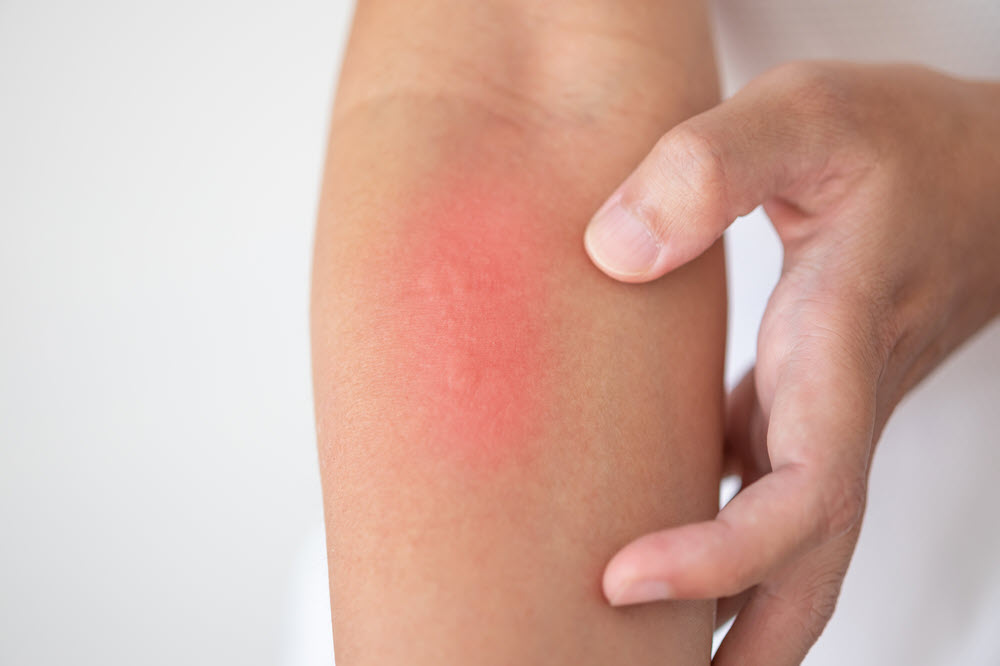Skin & Esthetics
Heat Rash
By S.I. (staff writer) , published on November 04, 2021

Medicine Telehealth Health skin rash itching
What is a Heat Rash?
A heat rash arises when sweat glands in the skin become clogged due to various reasons. Sweat glands obstruction hinders moisture from reaching out to the surface of the skin. As a result, inflammation manifests itself in the form of a rash [1].
Heat rash is a common skin ailment that strikes both children and adults in sunny and warm weather conditions. It is an unpleasant but usually harmless condition. After a few days, it normally improves on its own.
Heat rash is frequently caused by the effect of friction on the surface of the human body. Adults typically experience heat rash where their bodies rub against each other, such as between the inner thighs or beneath the arms.
There are many distinct types of skin rashes. They can be alarming, inconvenient, or even painful. Heat rash, commonly known as miliaria, is one of the most prevalent forms [2].
What Causes a Heat Rash?
The purpose of skin is to keep the inside of the body safe from the surrounding hazards. It functions as a deterrent to intruders such as bacteria, pollutants, and ultraviolet light from infiltrating or harming the system. The skin uses various barriers such as sweat to perform this function.
However, in case of excessive sweat production, these sweat ducts can become obstructed. As a result, sweat cannot escape from the body, leading to a heat rash [3].
The following are some instances of how this sweat-occlusion can occur:
- Skin pressing in crevices such as the collar, underarm, or pubic area making it harder for the air to flow and, therefore, hindering sweat evaporation.
- Clothing that is too tight to allow sweat to evaporate.
- Putting on heavy clothing or linens to keep warm. This might happen when a person tries to remain warm in the winter or when they are chilly due to a fever.
- Thick lotions or cosmetics can also clog sweat ducts.
What are the Symptoms of Heat Rash?
Heat rash is characterized by red lumps on the skin as well as an itchy or prickly sensation. The prickly feeling is comparable to that of lightly sunburnt skin and is caused by irritation of the skin's superficial layers.
The following are some common symptoms [4]:
- A high temperature
- A persistent cough
- A stuffy nose
- Fatigue
- Swelling in lymph nodes
- Pain in the muscles
What are the Types of Heat Rash?
There are mainly three types of heat rashes [5]:
- Miliaria crystallina
- Miliaria Rubra
- Miliaria profunda
What are the Treatment Options?
Heat rash usually goes away after the skin cools down, although the sweat glands can become infected in rare cases. Pustules may occur at the location of the rash. All such manifestations show that bacteria have infiltrated the blocked sweat gland and have caused illness. Antibiotics may be recommended in such conditions.
A doctor may suggest any of the following medicines:
- Calamine lotion (A drug used to heal mild skin irritation and itchiness)
- Benadryl (antihistamine)
- Hydrocortisone cream (This medication is not for children under the age of ten or pregnant women. Hence, they must seek medical advice before using it)
For the most part, heat rash is a minor annoyance that goes away in a few days.
References:
- https://pubmed.ncbi.nlm.nih.gov/30725861/
- https://www.ncbi.nlm.nih.gov/books/NBK537176/
- https://www.ncbi.nlm.nih.gov/books/NBK537176/#:~:text=Miliaria%2C%20also%20known%20as%20eccrine,eccrine%20sweat%20glands%20and%20ducts.
- https://www.ncbi.nlm.nih.gov/medgen/44443
- https://pubmed.ncbi.nlm.nih.gov/30725861/
Find articles related to: Medicine Telehealth Health skin rash itching
More articles about Skin & Esthetics
Back to the Health Tips Index




